Rafnia triflora
Rafnia triflora Thunb.
Family: Fabaceae
Common names: three-flower rafnia
Introduction
Rafnia triflora is a little known but striking fynbos shrub, with blue green leaves and bright yellow flowers in summer.
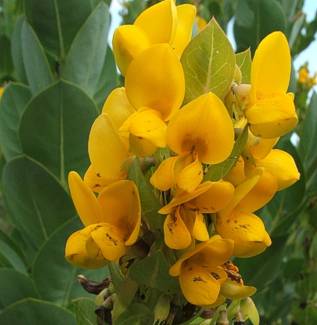
Description
Description
Rafnia triflora is an erect woody shrub up to 2.4 m high. It is multi-stemmed at ground level, with strong woody stems, reddish purple when young, arising from a persistent, fire-resistant, woody rootstock. The leaves are blue-green, simple, hairless, leathery and without a petiole (sessile). The veins are clearly visible, with a thick midrib and the veins extending from the midrib in a feather-like pattern.
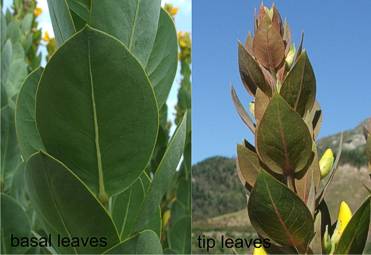
The leaves are much larger at the base of the stems and decrease in size towards the top. They are also differently shaped: those at the base are elliptic to rounded and those at the top nearly triangular with a rounded or heart-shaped base. The leaves turn black soon after cutting, making this species a poor cut flower.
The inflorescence is made up of a number of bright yellow pea flowers along the tips of the branches. It is made up of many single flowers but they emerge in groups of three in the axils of the leaves giving the appearance of a three-flowered inflorescence. Flowering time is from spring to late summer (September- March).
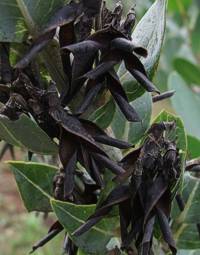
The pods dry black and remain on the bush long after they have split open and released their seeds.
Conservation Status
Status
Least Concern. Rafnia triflora is not threatened.
Distribution and habitat
Distribution description
Rafnia triflora is a Western Cape endemic and is found in mountain and coastal fynbos. It occurs from Clanwilliam and Piketberg, to the Cape Peninsula and eastwards to Knysna. This species occupies in many habitats, from river mouths, to mountain peaks, and is most often seen growing in soil derived from Table Mountain Sandstone but also grows in granitic and shale soils.
Derivation of name and historical aspects
History
The genus Rafnia was named after Karl G. Rafn (1769-1808), a Danish scientist and botanist who wrote a book about Danish native plants. The species epithet triflora means three-flowered, referring to the arrangement of the flowers.
The genus Rafnia contains about 22 species that occur only in southern Africa and mostly in the Western Cape; the range of only one species, R. elliptica, stretches into KwaZulu-Natal. Rafnia belongs in the Pea Family (Fabaceae) and is most closely related to Aspalathus, Lebeckia and Wiborgia.
Ecology
Ecology
Rafnia triflora is adapted to the winter rainfall weather patterns of the Western Cape and is found only in fynbos. The fynbos is a fire-prone vegetation type. Rafnias survive fires by re-sprouting from a fire-resistant, woody rootstock, known as a lignotuber, and are amongst the first plants to appear after fires.
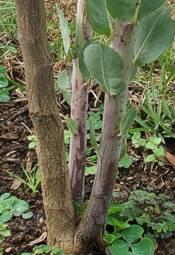
Uses
Use
Rafnia triflora is not known to be used medicinally, but other rafnias are.e.g. R. amplexicaulis roots are used as a substitute for liquorice, and R. perfoliata, when boiled, produces a drug that increases the production and excretion of urine (diuretic).
From a horticultural perspective, although it is not well known to gardeners and is not available for sale in garden centres, this attractive shrub is suited to garden cultivation and is deserving of a place. It is perhaps best suited to the fynbos garden, or the winter rainfall water-wise garden, but is equally suited to 'regular' gardens where it can be planted in the shrubbery, or at the back of the mixed border.
Rafnia triflora is not a good cut flower because the leaves turn black soon after the stem is cut.
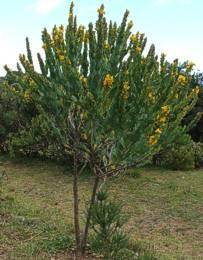
Growing Rafnia triflora
Grow
Rafnia triflora is not cultivated or propagated at Kirstenbosch as yet, but we would treat it like other fynbos legumes such as Aspalathus, Liparia and Cyclopia.
Grow Rafnia triflora in a sunny position, in well-drained, acidic soil. Prune after flowering to promote dense, bushy growth and keep tidy. Feed with well-rotted compost or slow-release fertiliser. Water well during autumn-winter-spring and moderately during summer.
Rafnia triflora is well suited to the fynbos garden, the Mediterranean garden, or the water-wise garden in a winter rainfall area but should also do well in gardens outside of its natural range. It is suited to the shrubbery, or the back of the mixed border. R. triflora should do well in large pots or tubs on a sunny patio or in a courtyard garden.
Rafnia triflora is probably easiest to propagate from seed as many of the fynbos legumes are difficult to root from cuttings. Start the process by sorting the good seeds from the bad seeds with a water viability test: put the seeds in a glass jar half filled with water, the good seeds will sink and the bad seeds will float. Discard the bad seeds and scarify the good seeds to weaken the seed coat to allow water to penetrate.
At Kirstenbosch a cylindrical container with sandpaper on the inside is used to scarify seeds. At home, the seeds can be rubbed with sandpaper or some of the seed coat can be scraped off with a sharp knife, but take care not to damage the embryo or your fingers. Put the scarified seeds in warm water and leave over night before sowing. Being a fire-adapted plant, treating the seed with Instant Smoke Plus Seed Primer should increase the percentage germination.
Sow seed in late summer to autumn (March-April-May), in a fynbos mix, i.e. one that comprises 1 part loam, 8 parts milled pine bark, 3 parts river sand and add 200g ammonium sulphate. Cover with a fine layer of river sand and water. Treating the seed with a fungicide that combats pre- and post-emergence damping off will increase the number of healthy seedlings. Place the tray in a warm position but not in direct sun, e.g. under an opaque fibre glass roof. Keep moist but not wet. Expect germination in two to six weeks.
Transplant the seedlings as soon as they are large enough to handle.
Try semi-hardwood tip cuttings, or semihardwood growth straight from the rootstock, taken in late summer to autumn, or in spring to early summer. Use rooting hormone and place in a mist unit with bottom heat.
References
- Cambell, G.J. & van Wyk, B.-E. 2001. A taxonomic revision of Rafnia (Fabaceae, Crotalarieae). South African Journal of Botany : 67: 90-149.
- Goldblatt, P. & Manning, J.C. 2000. Cape plants. A conspectus of the Cape flora of South Africa. Strelitzia 9. National Botanical Institute, Pretoria & Missouri Botanical Garden Press, Missouri.
- Manning, J. 2007. Field guide to fynbos. Struik Publishers, Cape Town.
- Trinder-Smith, T. 2006. Wild flowers of the Table Mountain National Park. South African Wild Flower Guide 12. Botanical Society of South Africa, Cape Town.
- Notten, A. 2008-3. Liparia splendens (Burm.f.) Bos & De Wit subsp. splendens (Fabaceae). Internet 5 pp. http://www.plantzafrica.com/plantklm/lipariasplend.htm
- Leistner, O.A. (ed.). 2000. Seed plants of southern Africa : families and genera. Strelitzia 10. National Botanical Institute, Pretoria.
- Jackson, W.P.U. 1990. Origins and meanings of names of South African plant genera. U.C.T. Printing Dept., Cape Town.
- Kesting, D. & Clarke, H. 2008. Botanical names what they mean, Wild flowers of the Cape Peninsula, 3rd revised and enlarged edition. Flora Documentation Programme, Friends of Silvermine Nature Area (FOSNA), Port Elizabeth.
Credits
Musawenkosi Ndlovu & Alice Notten
Kirstenbosch NBG
March 2010
Plant Attributes:
Plant Type: Shrub
SA Distribution: Western Cape
Soil type: Sandy, Clay, Loam
Flowering season: Spring, Early Summer, Late Summer
PH: Acid
Flower colour: Yellow
Aspect: Full Sun
Gardening skill: Average
Special Features:
Horticultural zones








Rate this article
Article well written and informative
Rate this plant
Is this an interesting plant?
Login to add your Comment
Back to topNot registered yet? Click here to register.